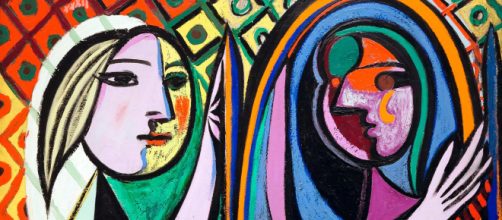You might call today’s column “letting the genie out of the bottle.” But first a word about the bottle. The sparkle and shine of glassware with all its myriad reflections can be riveting.
Clara Peeters’ “Still Life with Chess, Almonds and Pretzels” rivets like that if you look closely at the glass pitcher standing behind the cheese. That’s when you can catch her reflection.
But that tour de force aside, Peeters' painting has no particular meaning. And without a story to tell, the pleasure of seeing her work is self-limiting. I liken it to staring in wonder at the reflection of the sun on a body of water.
Without much more to hold your attention, you move on.
That’s my reaction to the glassware paintings of Seoul artist Eunkyoung Son featured in this week’s The Guardian. And the way she talks about glass is also self-limiting: “I love that it distorts the things behind it, not reflecting them in its form directly. It feels so fun to express it two-dimensionally...”
I get the fun part. But what if you could have that and a story, too? I’m thinking of “Girl Before the Mirror” by Picasso, who didn’t just record reflections in glass; he also manipulated them into something more.
Reflections of a second kind
At first what you see is the figure (Picasso’s mistress Marie-Therese Walter) standing before a full-length mirror gazing at her reflection.
You also see her both dressed and undressed and even what looks like an X-ray view of her anatomy.
Wait, there’s more. Besides a full face, you also get a profile, as if she were in motion. The colors, stripes, and dots also look to be in motion. Yet, that’s not all, either.
To hear art historian Robert Rosenblum tell it in William Rubin’s 1961 book “Picasso and Portraiture” the duality of the face – one dark, one light – stands for the polarity between virgin and whore. He said those archetypes haunted Picasso.
Art historian Debbie Goldberg went still further, contending that “Girl Before a Mirror” is a portrait of death. (This can’t be right since the kaleidoscope of vibrating reds and oranges speaks of life, not the end of it).
Of course, it’s utterly unfair to compare an emerging painter like Eunkyoung Son with the likes of Picasso. She deserves credit for capturing the glittering qualities of glass, especially the unexpected beauty she found in an ordinary tumbler. But is fixating on the reflections of glassware artmaking?
What else is there?
Mind you, this is not to say that art always needs a tale or a testimony. Consider Henri Matisse’s painting “Still Life with a Pewter Jug and Pink Statuette.”
His picture may lack yarn, but it’s very much about something. I call it artmaking. The content of Matisse’s still life is unnaturally vivid, as if to escape the rules of realism. In this way, Matisse marked the start of modernism.
Yet, Picasso did modernism better. His “Girl Before a Mirror” not only escapes the rules of realism but also recites his romance with Walter. Eunkyoung Son's paintings of glassware are like piano exercises - warm-ups before playing music.


